Читать книгу The Art of Foreign Language Teaching - Peter Lutzker - Страница 20
1.2.9 Reform Movements – Overview
ОглавлениеA comparison of Weber’s and Steiner’s writings makes clear that behind the general concept of viewing teaching as an art, similarities as well as distinctions exist. Although many of these aspects were unique to these particular two movements, the same phenomenon would be apparent in comparing any of the other reform movements of that period. Clearly, the concept of teaching as an art prevalent at that time was broad enough to include a range of standpoints, each with their own specific emphasis and focus.
The conflicts which emerged in this period between the proponents of viewing teaching as an art and the advocates of an experimental pedagogy based on viewing teaching and learning in the context of an educational science, evidence parallels to discussions still held today. These parallels are particularly striking when one considers the vastly different societies in which these debates have taken place. In looking back at the educational reform movements at the beginning of the 20th century, A. Flitner points out that practically all the questions which were debated and put into educational practice at that time, were still being debated at the end of the century:
In the first third of the century, practically all the determinative questions of ‘modern’ education were already raised and nearly all the ideas that inform our current questions and discussions were put into practice.77
In the midst of national and international educational crises in the first decades of the 21st century, this appears to be no less relevant. Despite the almost inconceivable differences between the German Kaiserreich and contemporary European and/or American societies, the underlying issues have remained constant.
